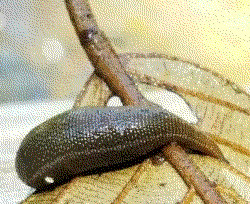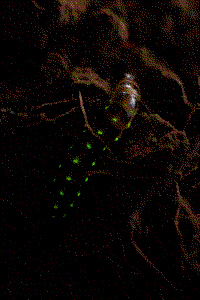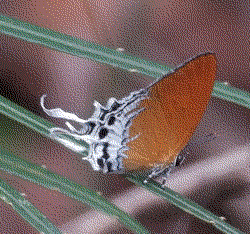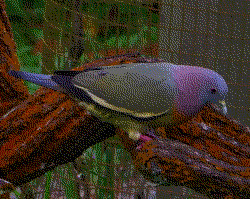Pacat
4.viii.2023

One of the most dreadful animals of the rainforest, the pacat. Known as the land leech in English. The English language is particularly poor at describing leeches, having to append the words "water" and "land" to properly describe aquatic and terrestrial leeches. In Malay, the land leech is the pacat, while the water leech is the lintah. Pacat are typically only found in the subtropical and tropical regions of the world, they need a somewhat wet atmosphere so they don't dry out while on land.
Pacat hang off the leaves of shrubs, waiting for a passing mammal. It then grabs on and climbs in with an inching motion towards a hidden spot, like between the folds of skin or under some clothing. Once it reaches a suitable spot, it begins cutting through the skin with its jaws. It has three saw-like jaws that it uses to cut a circular hole into the skin of its host, where it releases its saliva, a cocktail of anticoagulants and substances that numb the wound. Once it is fat and full of blood, it drops off and settles somewhere to digest its meal.
Needless to say I don't like them at all. If you have to do field work in the rainforest, you end up having to peel at least a couple off your body by the end of the day. There are ways to keep them away, usually through the use of socks (Field workers usually wear long football socks which the tuck their pants into, so leeches don't get into their pants) and by frequently checking places that pacat like to feed at.
When I was a more junior researcher, I used to get so many of them on me after field work that I got really frustrated with them. I contacted a leech expert and asked him if he wanted any specimens. If they insisted on coming to me I might as well get some research out of it. I eventually got involved with a project to extract mRNA from them (I was dealing with mRNA before it was a mainstream word). And at the point when I needed to get some fresh specimens, suddenly they stopped coming for me. Animals never show up when you are looking for them. Instead of picking them off after field work, I actually had to go look for them and randomly walk through the forest and try to pick up a few on my body.
I finally managed to get some leeches, the project was done and some stuff was published from the collaboration. A few years later I heard that the leech expert was a fired for some sexual harassment allegations. I'll never know the full story, but I should be more careful with my collaborations in the future.




